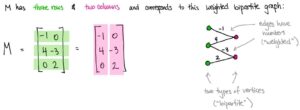Today I’d like to share an idea. It’s a very simple idea. It’s not fancy and it’s certainly not new. In fact, I’m sure many of you have thought about it already. But if you haven’t—and even if you have!—I hope you’ll take a few minutes to enjoy it with me. Here’s the idea:

So simple! But we can get a lot of mileage out of it.
To start, I’ll be a little more precise: every matrix corresponds to a weighted bipartite graph. By “graph” I mean a collection of vertices (dots) and edges; by “bipartite” I mean that the dots come in two different types/colors; by “weighted” I mean each edge is labeled with a number.
The graph above corresponds to a 3×23×2 matrix MM. You’ll notice I’ve drawn three greengreen dots—one for each row of MM—and two pinkpink dots—one for each column of MM. I’ve also drawn an edge between a green dot and a pink dot if the corresponding entry in MM is non-zero.

For example, there’s an edge between the second green dot and the first pink dot because M21=4M21=4, the entry in the second row, first column of MM, is not zero. Moreover, I’ve labeled that edge by that non-zero number. On the other hand, there is no edge between the first green dot and the second pink dot because M12M12, the entry in the first row, second column of the matrix, is zero.
Allow me to describe the general set-up a little more explicitly.
Any matrix MM is an array of n×mn×m numbers. That’s old news, of course. But such an array can also be viewed as a function M:X×Y→RM:X×Y→R where X={x1,…,xn}X={x1,…,xn} is a set of nn elements and Y={y1,…,ym}Y={y1,…,ym} is a set of mm elements. Indeed, if I want to describe the matrix MM to you, then I need to tell you what each of its ijijth entries are. In other words, for each pair of indices (i,j)(i,j), I need to give you a real number MijMij. But that’s precisely what a function does! A function M:X×Y→RM:X×Y→R associates for every pair (xi,yj)(xi,yj) (if you like, just drop the letters and think of this as (i,j)(i,j)) a real number M(xi,yj)M(xi,yj). So simply write MijMij for M(xi,yj)M(xi,yj).
Et voila. A matrix is a function.
For more such insights, log into www.international-maths-challenge.com.
*Credit for article given to Tai-Danae Bradley*

